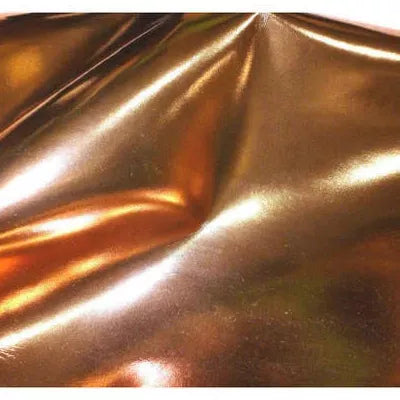Metallic leather has taken the fashion and décor worlds by storm. Its shimmering surface adds an eye-catching dimension to various products, making it a favorite among designers and DIY enthusiasts alike. Metallic effects on leather are not just about aesthetics; they can also enhance the durability and water resistance of the material, making it a practical choice for a range of applications.

In fashion, metallic leather is often seen in high-end shoes, handbags, belts, and outerwear. Its reflective quality adds a luxurious feel to any item, making it a popular choice for evening wear and statement pieces. In home décor, metallic leather is used in upholstery, cushions, and accessories, bringing a modern, chic vibe to interior spaces. Whether you want to make a bold fashion statement or add a touch of sophistication to your home, metallic leather offers endless possibilities.
Materials Needed
Before you begin your journey into metallic leather painting, it’s essential to gather all the necessary materials. Here’s a comprehensive list to ensure you’re fully prepared:
1. Types of Metallic Paints:
- Acrylic-based metallic leather paint: Specially formulated for leather, these paints are flexible and adhere well to the surface without cracking.
- Spray metallic paint: Ideal for achieving an even, smooth finish over large surfaces.
- Oil-based metallic paint: Provides a richer color but requires more drying time and additional protective coatings.
2. Preparation Tools:
- Leather cleaner: A dedicated leather cleaner or a mixture of mild soap and water to remove dirt and oils.
- Leather deglazer: Essential for removing any existing finishes on the leather, ensuring better paint adherence.
- Fine-grit sandpaper: Use fine-grit sandpaper for lightly scuffing the surface to enhance paint absorption.
3. Application Tools:
- Brushes: Various sizes of synthetic brushes for detailed work and broad strokes.
- Sponges: Great for achieving textured effects or for blending colors.
- Airbrush or spray gun: For an even and professional finish, especially on large surfaces.
- Painter’s tape: To mask off areas you don’t want to paint.
- Gloves: To protect your hands from paint and chemicals.
- Drop cloths: To protect your workspace from spills and splatters.
Preparation of Leather

Proper preparation is crucial to ensure that the metallic paint adheres well to the leather and lasts over time. Follow these steps to prepare your leather surface effectively:
Step 1: Cleaning the Leather
- Begin by cleaning the leather surface with a leather cleaner or a mixture of mild soap and water. Use a soft cloth to gently wipe away dirt, oils, and any other contaminants. Allow the leather to dry completely.
Step 2: Deglazing the Leather
- Apply a leather deglazer to remove any existing finishes on the leather. This step is particularly important if the leather has been previously treated or painted. Use a lint-free cloth to apply the deglazer in a circular motion. Once the surface is matte and free of shine, let it dry for about 15-20 minutes.
Step 3: Light Sanding (Optional)
- If your leather surface is particularly glossy or smooth, lightly sanding it with fine-grit sandpaper can help the paint adhere better. Be sure to wipe away any dust with a damp cloth and allow the leather to dry completely before proceeding to painting.
Application Techniques

Creating metallic leather effects involves mastering a few key application techniques. Here’s a detailed guide to help you achieve the look you desire:
1. Sponge Painting:
- Technique: Dampen a sponge slightly, dip it into the metallic paint, and dab it onto the leather surface in a stippling motion. This technique is ideal for creating a textured, shimmering effect that catches light from different angles.
- Best For: Small accessories like wallets, belts, or accents on larger items.
2. Brush Strokes:
- Technique: Use synthetic brushes to apply the metallic paint in long, even strokes. For a more artistic effect, you can vary the pressure and direction of your brush strokes to create depth and movement in the design.
- Best For: Creating custom metallic leather designs on larger surfaces like jackets, shoes, or upholstery.
3. Spray Application:
- Technique: Using an airbrush or spray gun, apply thin, even layers of metallic paint to the leather surface. This method is excellent for achieving a smooth, professional finish with minimal texture.
- Best For: Large projects like sofas, car interiors, or any surface where a consistent finish is desired.
4. Layering and Blending:
- Technique: To create a more complex and dynamic effect, try layering different metallic colors. Start with a base coat of one color, then gradually add other metallic shades, blending them with a brush or sponge while the paint is still wet.
- Best For: Artistic projects where you want to create depth, such as metallic leather artwork or custom-designed fashion items.
Types of Metallic Finishes
Metallic finishes come in a variety of colors and styles, each offering a unique aesthetic. Here are some popular options and their applications:
1. Gold:
- Appearance: Luxurious and warm, gold metallic leather is perfect for creating statement pieces.
- Applications: Shoes, handbags, belts, and furniture accents.
2. Silver:
- Appearance: Sleek and modern, silver adds a cool, sophisticated touch to leather items.
- Applications: Jackets, wallets, car interiors, and tech accessories.
3. Rose Gold:
- Appearance: A blend of gold and copper, rose gold has a softer, more feminine appeal.
- Applications: Jewelry, handbags, phone cases, and home décor items.
4. Bronze and Copper:
- Appearance: Earthy and rustic, these metallic finishes are great for a vintage or industrial look.
- Applications: Footwear, belts, watch straps, and interior décor.
5. Iridescent Finishes:
- Appearance: These finishes shift colors depending on the angle of light, offering a dynamic and eye-catching effect.
- Applications: High-fashion items, avant-garde accessories, and custom artwork.
Styling and Fashion Integration
Metallic leather is incredibly versatile, fitting seamlessly into various fashion styles and trends. Here’s how you can integrate it into your wardrobe and décor:
1. Footwear:
- Metallic leather shoes, whether they’re pumps, sneakers, or boots, can instantly elevate any outfit. Pair them with neutral tones for a balanced look, or go bold by combining them with bright, contrasting colors.
2. Handbags and Accessories:
- A metallic leather handbag can be a standout piece in any ensemble. For a more understated look, choose a small clutch or wallet in a metallic finish. Other accessories like belts, hats, and gloves can also benefit from a touch of metallic shine.
3. Outerwear:
- Metallic leather jackets are a fashion-forward choice that adds edge to any look. Whether you opt for a full metallic finish or just metallic accents, these pieces are sure to turn heads.
4. Home Décor:
- Incorporate metallic leather into your home by choosing upholstery with a metallic finish. Pillows, throws, and even leather-covered furniture can benefit from this trend, adding a touch of glamor and modernity to your space.
Maintenance and Care
Keeping your metallic leather items in pristine condition requires proper maintenance. Here’s how to ensure they retain their shine and durability:
1. Regular Cleaning:
- Dust and dirt can dull the metallic finish over time. Use a soft, dry cloth to gently wipe down the leather after each use. For more thorough cleaning, use a damp cloth with mild soap, but avoid soaking the leather.
2. Conditioning:
- Metallic leather can dry out if not properly conditioned. Use a leather conditioner specifically designed for metallic finishes, applying it sparingly to avoid altering the texture or color. Conditioning should be done every few months, depending on use.
3. Protecting the Finish:
- To prevent scuffs and scratches, consider applying a clear protective coating designed for leather. This will also help maintain the metallic sheen over time.
4. Storage:
- Store metallic leather items in a cool, dry place away from direct sunlight, which can cause fading. Use dust bags or cloth covers to protect them from dust and scratches.
Troubleshooting Common Issues
Despite your best efforts, you may encounter some challenges when working with metallic leather paint. Here are solutions to common problems:
1. Cracking Paint:
- Solution: Ensure the leather is properly prepared and the paint is applied in thin, even layers. Overloading the leather with too much paint at once can cause it to crack. Use a flexible leather paint designed to move with the leather.
2. Uneven Finishes:
- Solution: Uneven finishes often result from inadequate surface preparation or inconsistent application. Make sure the leather is clean, dry, and properly deglazed before painting. Use a spray gun or airbrush for the most even application.
3. Fading Colors:
- Solution: Fading can be minimized by applying a clear protective coating over the metallic paint. Store the leather item away from direct sunlight and reapply conditioner periodically to maintain the color.
Creating metallic effects on leather is a rewarding process that combines creativity with craftsmanship. Whether you're customizing a piece for your wardrobe or adding a luxurious touch to your home décor, the techniques and tips outlined in this guide will help you achieve professional results.
Remember, the key to success lies in careful preparation, choosing the right materials, and applying your chosen techniques with precision. With practice, you’ll be able to create stunning metallic leather pieces that reflect your unique style.
or selecting the right paints and tools, check out Angelus Direct, Angelus Direct offers a range of products specifically designed for leather customization.
FAQs
1. What types of paint work best for metallic effects on leather?
- Answer: The best paints for creating metallic effects on leather are acrylic-based metallic paints, which are specifically formulated for leather surfaces. These paints are flexible and adhere well, reducing the risk of cracking. You can find a variety of options at Angelus Direct, a trusted source for leather paints.
2. How do I prevent the metallic paint from cracking?
- Answer: To prevent cracking, ensure that the leather surface is properly prepared before painting. Apply the paint in thin, even layers, allowing each layer to dry completely before adding the next. Using a flexible leather paint is also crucial.
3. Can metallic leather be treated for outdoor use?
- Answer: Yes, metallic leather can be treated for outdoor use by applying a clear protective coating designed to seal and protect the paint from the elements. Regular conditioning and proper storage will also help maintain its appearance.
4. What are some fashion-forward ways to incorporate metallic leather into my wardrobe?
- Answer: Metallic leather can be integrated into your wardrobe through various items like shoes, handbags, jackets, and belts. Pair metallic accessories with neutral clothing for a chic, balanced look, or use them to add a pop of color and shine to your outfits.
5. How often should metallic leather be conditioned?
- Answer: Metallic leather should be conditioned every few months, depending on how frequently it’s used. Regular conditioning helps maintain the leather’s flexibility and shine, preventing it from drying out or cracking.

